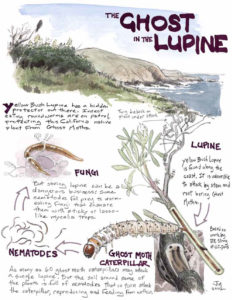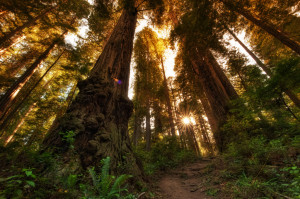Albino redwood trees, first documented in 1866, have been a mystery for as long as we’ve known they were out there. More than 400 albino redwoods have been found in California and the Pacific Northwest, with the greatest concentration occurring in Santa Cruz County.
They sprout from the roots of a normal parent tree and typically aren’t more than 10 feet tall. A genetic mutation causes them to lack chlorophyll, which, apart from turning them white, means they cannot make their own food. So to survive, the albino redwood shares nutrients from the roots of its parent, and therein lies an evolutionary mystery: Why would a healthy tree have a shoot that doesn’t appear to confer any advantages to the parent tree?
In 2010, Zane Moore, a botany undergraduate student at Colorado State, saw a KQED Quest feature on the mystery of the albino redwoods and was inspired. Moore (who’s now a graduate student at UC Davis) wondered why redwoods wouldn’t just shed their albino shoots in the summer, as they generally do with branches and needles that aren’t pulling their weight.
“Somehow, a significant number of the albinos are making the cut in summer,” Moore says, “and that suggested to me that they might be serving some function.”
Moore’s collaborator, arborist Tom Stapleton, first tried to grow albino redwoods from cuttings of part-green, part-white trees, but over three years all the new growth was green, Moore says. He started to wonder what the difference might be between the wild conditions under which the albinos were appearing and the lab conditions in which they refused to grow. So he and Moore analyzed the tissues of wild albinos from 11 sites spanning Mendocino, Sonoma, and Santa Cruz counties. The analysis revealed high concentrations of heavy metals like nickel, copper, and cadmium.
Perhaps, Moore and Stapleton thought, albinos were extracting toxins from the soil. In 2017 they’ll test the idea with an experiment in which they cultivate a group of half-albino, half-green redwoods in a greenhouse and then dose half the group with toxins like those that were found in the wild albinos.
In a year, they will be able to evaluate whether the two groups of trees grow differently—and perhaps begin to solve the century-old mystery of these ghosts of the forest.



